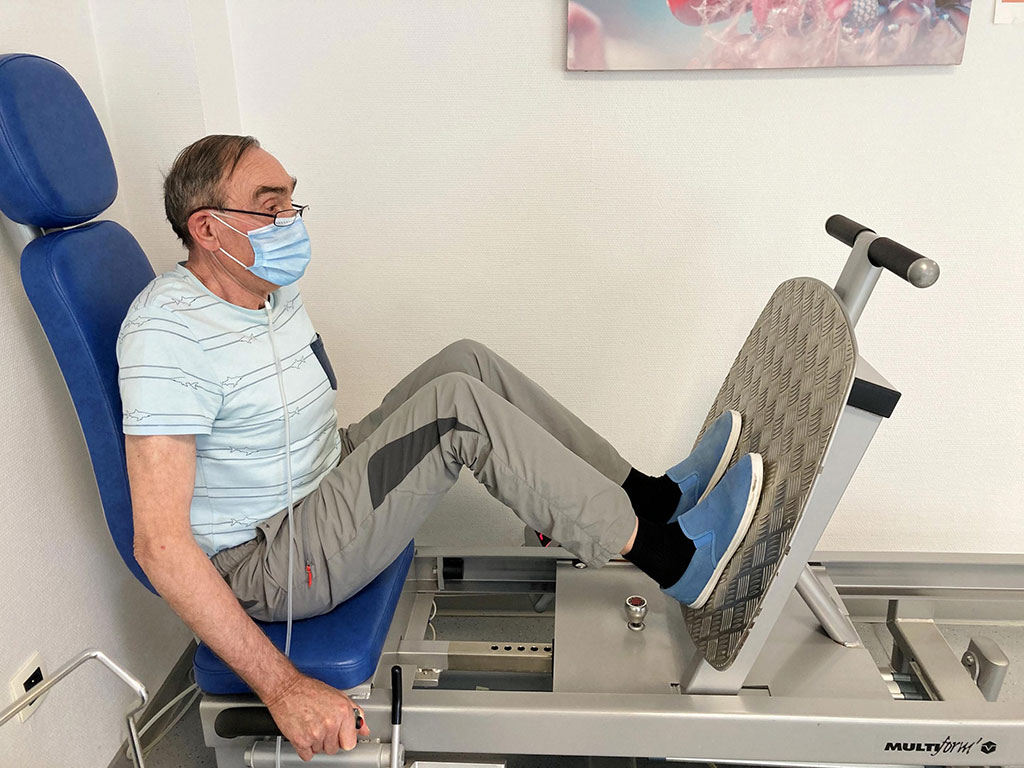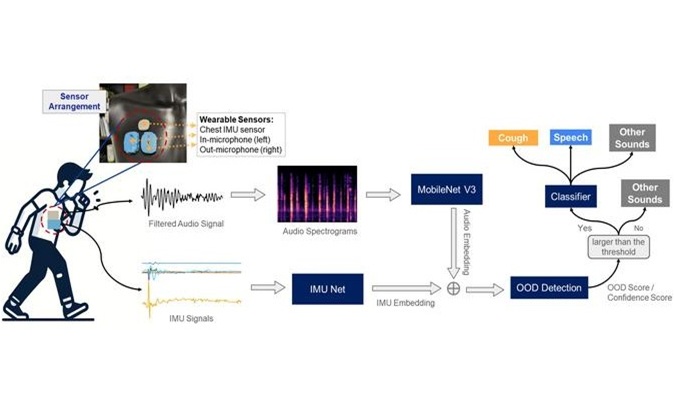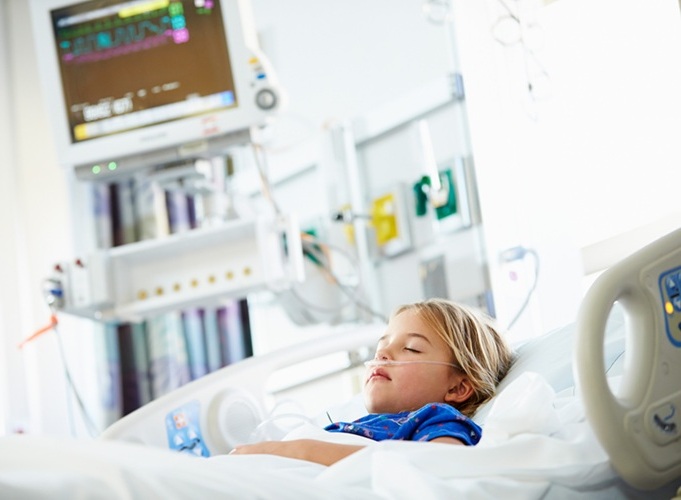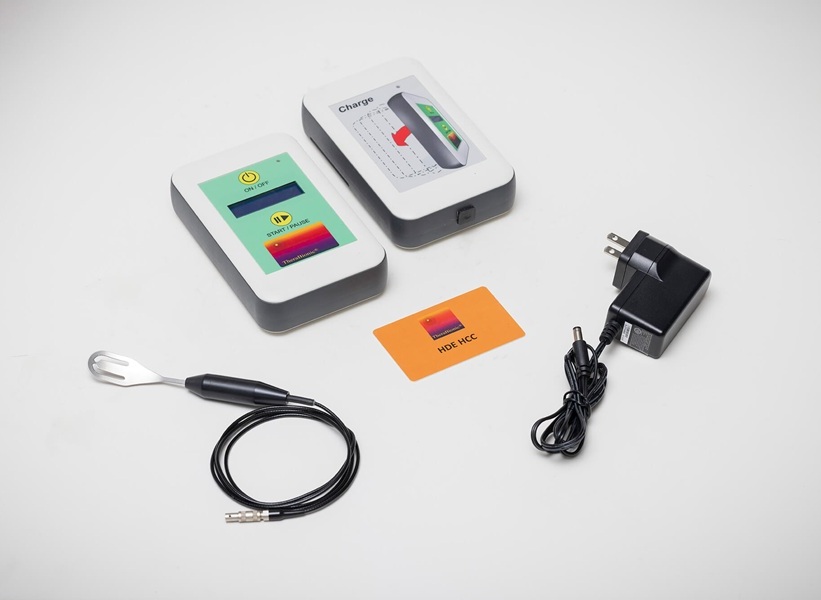CT Scans of COVID-19 “Long-Haulers” Reveal Damaged Lungs Begin Repairing Themselves After 12 Weeks
|
By HospiMedica International staff writers Posted on 16 Sep 2020 |

Image: Image shows a recovering COVID-19 patient taking part in rehabilitation programme (Photo courtesy of Frédéric Hérengt)
COVID-19 patients can suffer long-term lung and heart damage but, for many, this tends to improve over time, according to the first, prospective follow-up of patients infected with the coronavirus, presented at the European Respiratory Society International Congress.
For their study, researchers from the University Clinic of Internal Medicine (Innsbruck, Austria) recruited consecutive coronavirus patients to their study who were hospitalized. The patients were scheduled to return for evaluation six, 12 and 24 weeks after their discharge from hospital. During these visits, clinical examinations, laboratory tests, analysis of the amounts of oxygen and carbon dioxide in arterial blood, lung function tests, computed tomography (CT) scans and echocardiograms were carried out. At the time of their first visit, more than half of the patients had at least one persistent symptom, predominantly breathlessness and coughing, and CT scans still showed lung damage in 88% of patients. However, by the time of their next visit 12 weeks after discharge, the symptoms had improved and lung damage was reduced to 56%.
The CT scans showed that the score that defines the severity of overall lung damage decreased from eight points at six weeks to four points at twelve weeks. Damage from inflammation and fluid in the lungs caused by the coronavirus, which shows up on CT scans as white patches known as ‘ground glass’, also improved.
“The bad news is that people show lung impairment from COVID-19 weeks after discharge; the good news is that the impairment tends to ameliorate over time, which suggests the lungs have a mechanism for repairing themselves,” said Dr. Sabina Sahanic, who is a clinical PhD student at the University Clinic in Innsbruck and part of the team that carried out the study. “The findings from this study show the importance of implementing structured follow-up care for patients with severe COVID-19 infection. Importantly, CT unveiled lung damage in this patient group that was not identified by lung function tests. Knowing how patients have been affected long-term by the coronavirus might enable symptoms and lung damage to be treated much earlier and might have a significant impact on further medical recommendations and advice.”
In a second poster presentation to the Congress, Ms. Yara Al Chikhanie, a PhD student at the Dieulefit Santé clinic for pulmonary rehabilitation (Dieulefit, France; and the Hp2 Lab at the Grenoble Alps University (Isère, France), said that the sooner COVID-19 patients started a pulmonary rehabilitation program after coming off ventilators, the better and faster their recovery. Chikhanie used a walking test to evaluate the weekly progress of 19 patients who had spent an average of three weeks in intensive care and two weeks in a pulmonary ward before being transferred to the Dieulefit Santé clinic for pulmonary rehabilitation. Most were still unable to walk when they arrived, and they spent an average of three weeks in rehabilitation. The walking test measured how far the patients could walk in six minutes. At the beginning, they were able to walk an average of 16% of the distance that, in theory, they should be able to walk normally if healthy. After three weeks of pulmonary rehabilitation, this increased to an average of 43%, which was a significant gain but still a serious impairment.
“The most important finding was that patients who were admitted to pulmonary rehabilitation shortly after leaving intensive care, progressed faster than those who spent a longer period in the pulmonary ward where they remained inactive,” said Chikhanie. “The sooner rehabilitation started and the longer it lasted, the faster and better was the improvement in patients’ walking and breathing capacities and muscle gain. Patients who started rehabilitation in the week after coming off their ventilators progressed faster than those who were admitted after two weeks.”
Related Links:
University Clinic of Internal Medicine
Hp2 Lab at the Grenoble Alps University
For their study, researchers from the University Clinic of Internal Medicine (Innsbruck, Austria) recruited consecutive coronavirus patients to their study who were hospitalized. The patients were scheduled to return for evaluation six, 12 and 24 weeks after their discharge from hospital. During these visits, clinical examinations, laboratory tests, analysis of the amounts of oxygen and carbon dioxide in arterial blood, lung function tests, computed tomography (CT) scans and echocardiograms were carried out. At the time of their first visit, more than half of the patients had at least one persistent symptom, predominantly breathlessness and coughing, and CT scans still showed lung damage in 88% of patients. However, by the time of their next visit 12 weeks after discharge, the symptoms had improved and lung damage was reduced to 56%.
The CT scans showed that the score that defines the severity of overall lung damage decreased from eight points at six weeks to four points at twelve weeks. Damage from inflammation and fluid in the lungs caused by the coronavirus, which shows up on CT scans as white patches known as ‘ground glass’, also improved.
“The bad news is that people show lung impairment from COVID-19 weeks after discharge; the good news is that the impairment tends to ameliorate over time, which suggests the lungs have a mechanism for repairing themselves,” said Dr. Sabina Sahanic, who is a clinical PhD student at the University Clinic in Innsbruck and part of the team that carried out the study. “The findings from this study show the importance of implementing structured follow-up care for patients with severe COVID-19 infection. Importantly, CT unveiled lung damage in this patient group that was not identified by lung function tests. Knowing how patients have been affected long-term by the coronavirus might enable symptoms and lung damage to be treated much earlier and might have a significant impact on further medical recommendations and advice.”
In a second poster presentation to the Congress, Ms. Yara Al Chikhanie, a PhD student at the Dieulefit Santé clinic for pulmonary rehabilitation (Dieulefit, France; and the Hp2 Lab at the Grenoble Alps University (Isère, France), said that the sooner COVID-19 patients started a pulmonary rehabilitation program after coming off ventilators, the better and faster their recovery. Chikhanie used a walking test to evaluate the weekly progress of 19 patients who had spent an average of three weeks in intensive care and two weeks in a pulmonary ward before being transferred to the Dieulefit Santé clinic for pulmonary rehabilitation. Most were still unable to walk when they arrived, and they spent an average of three weeks in rehabilitation. The walking test measured how far the patients could walk in six minutes. At the beginning, they were able to walk an average of 16% of the distance that, in theory, they should be able to walk normally if healthy. After three weeks of pulmonary rehabilitation, this increased to an average of 43%, which was a significant gain but still a serious impairment.
“The most important finding was that patients who were admitted to pulmonary rehabilitation shortly after leaving intensive care, progressed faster than those who spent a longer period in the pulmonary ward where they remained inactive,” said Chikhanie. “The sooner rehabilitation started and the longer it lasted, the faster and better was the improvement in patients’ walking and breathing capacities and muscle gain. Patients who started rehabilitation in the week after coming off their ventilators progressed faster than those who were admitted after two weeks.”
Related Links:
University Clinic of Internal Medicine
Hp2 Lab at the Grenoble Alps University
Latest COVID-19 News
- Low-Cost System Detects SARS-CoV-2 Virus in Hospital Air Using High-Tech Bubbles
- World's First Inhalable COVID-19 Vaccine Approved in China
- COVID-19 Vaccine Patch Fights SARS-CoV-2 Variants Better than Needles
- Blood Viscosity Testing Can Predict Risk of Death in Hospitalized COVID-19 Patients
- ‘Covid Computer’ Uses AI to Detect COVID-19 from Chest CT Scans
- MRI Lung-Imaging Technique Shows Cause of Long-COVID Symptoms
- Chest CT Scans of COVID-19 Patients Could Help Distinguish Between SARS-CoV-2 Variants
- Specialized MRI Detects Lung Abnormalities in Non-Hospitalized Long COVID Patients
- AI Algorithm Identifies Hospitalized Patients at Highest Risk of Dying From COVID-19
- Sweat Sensor Detects Key Biomarkers That Provide Early Warning of COVID-19 and Flu
- Study Assesses Impact of COVID-19 on Ventilation/Perfusion Scintigraphy
- CT Imaging Study Finds Vaccination Reduces Risk of COVID-19 Associated Pulmonary Embolism
- Third Day in Hospital a ‘Tipping Point’ in Severity of COVID-19 Pneumonia
- Longer Interval Between COVID-19 Vaccines Generates Up to Nine Times as Many Antibodies
- AI Model for Monitoring COVID-19 Predicts Mortality Within First 30 Days of Admission
- AI Predicts COVID Prognosis at Near-Expert Level Based Off CT Scans
Channels
Critical Care
view channel
Origami Robots to Deliver Medicine Less Invasively and More Effectively
Delivering medicine to ulcers or other internal sites often requires invasive procedures that can disrupt surrounding tissues and lengthen recovery times. Traditional magnetic actuators used in soft robotics... Read more
Improved Cough-Detection Technology Aids Health Monitoring
Coughing serves as an important biomarker for tracking a variety of conditions and can help monitor the progress of respiratory diseases or predict when someone’s asthma is being exacerbated.... Read moreSurgical Techniques
view channel
Novel Glue Prevents Complications After Breast Cancer Surgery
Seroma and prolonged lymphorrhea are among the most common complications following axillary lymphadenectomy in breast cancer patients. These postoperative issues can delay recovery and postpone the start... Read more
Breakthrough Brain Implant Enables Safer and More Precise Drug Delivery
Delivering medication directly to specific regions of the brain has long been a major challenge in treating neurological disorders. Current implants and infusion systems typically reach only one or two... Read morePatient Care
view channel
Revolutionary Automatic IV-Line Flushing Device to Enhance Infusion Care
More than 80% of in-hospital patients receive intravenous (IV) therapy. Every dose of IV medicine delivered in a small volume (<250 mL) infusion bag should be followed by subsequent flushing to ensure... Read more
VR Training Tool Combats Contamination of Portable Medical Equipment
Healthcare-associated infections (HAIs) impact one in every 31 patients, cause nearly 100,000 deaths each year, and cost USD 28.4 billion in direct medical expenses. Notably, up to 75% of these infections... Read more
Portable Biosensor Platform to Reduce Hospital-Acquired Infections
Approximately 4 million patients in the European Union acquire healthcare-associated infections (HAIs) or nosocomial infections each year, with around 37,000 deaths directly resulting from these infections,... Read moreFirst-Of-Its-Kind Portable Germicidal Light Technology Disinfects High-Touch Clinical Surfaces in Seconds
Reducing healthcare-acquired infections (HAIs) remains a pressing issue within global healthcare systems. In the United States alone, 1.7 million patients contract HAIs annually, leading to approximately... Read moreHealth IT
view channel
Printable Molecule-Selective Nanoparticles Enable Mass Production of Wearable Biosensors
The future of medicine is likely to focus on the personalization of healthcare—understanding exactly what an individual requires and delivering the appropriate combination of nutrients, metabolites, and... Read moreBusiness
view channel
Philips and Masimo Partner to Advance Patient Monitoring Measurement Technologies
Royal Philips (Amsterdam, Netherlands) and Masimo (Irvine, California, USA) have renewed their multi-year strategic collaboration, combining Philips’ expertise in patient monitoring with Masimo’s noninvasive... Read more
B. Braun Acquires Digital Microsurgery Company True Digital Surgery
The high-end microsurgery market in neurosurgery, spine, and ENT is undergoing a significant transformation. Traditional analog microscopes are giving way to digital exoscopes, which provide improved visualization,... Read more
CMEF 2025 to Promote Holistic and High-Quality Development of Medical and Health Industry
The 92nd China International Medical Equipment Fair (CMEF 2025) Autumn Exhibition is scheduled to be held from September 26 to 29 at the China Import and Export Fair Complex (Canton Fair Complex) in Guangzhou.... Read more

















